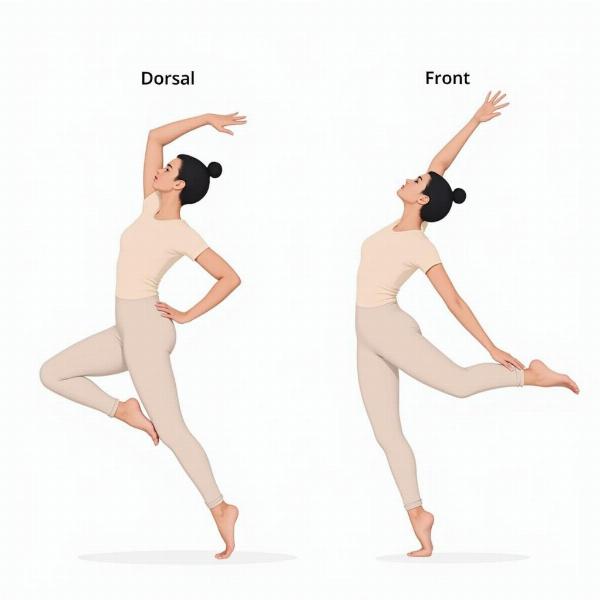Understanding the terms “dorsal” and “ventral” is crucial in various fields, from biology and medicine to yoga and even everyday conversation. While these terms seem simple, their meanings in Hindi can sometimes be confusing. This article aims to clarify the dorsal and ventral meaning in Hindi, providing clear explanations, relevant examples, and practical applications.
Decoding “Dorsal” in Hindi
The term “dorsal” refers to the back or upper side of an organism. In Hindi, the most common equivalent is पीठ (Peeth). Think of the dorsal fin of a dolphin – it’s located on its back. Similarly, the dorsal side of a leaf is the upper surface exposed to sunlight. Other related terms in Hindi include पृष्ठीय (Pṛṣṭhīya), which also means dorsal or relating to the back, and ऊपरी (Ūparī) meaning upper or top.
Understanding the different nuances of these terms is important. While Peeth generally refers to the back, Pṛṣṭhīya is often used in more scientific or technical contexts. Ūparī, while meaning “upper”, isn’t always synonymous with dorsal, especially when referring to objects that don’t have a clearly defined back.
Understanding “Ventral” in Hindi
“Ventral” refers to the front or underside of an organism. The most common Hindi equivalent is पेट (Pet), which literally translates to “belly” or “stomach”. Think of a snake slithering on its ventral side – its belly is in contact with the ground. Other relevant terms include अधर (Adhar) meaning lower or underneath, and निचला (Nichala), also meaning lower.
Like with “dorsal”, the context is crucial. While Pet is commonly used, Adhar might be preferred in a more formal setting or when discussing anatomy. Nichala, similar to Ūparī with “dorsal,” isn’t always a perfect synonym for ventral.
Dorsal and Ventral in Everyday Life and Specialized Fields
From describing the position of organs in the human body to understanding the anatomy of animals, the terms “dorsal” and “ventral” are ubiquitous. They also appear in yoga, where poses often involve bending or stretching the dorsal and ventral sides of the body. Even in common parlance, these terms can be useful. For example, you might describe a scratch on the ventral side of your car.
 Yoga Pose Demonstrating Dorsal and Ventral Sides
Yoga Pose Demonstrating Dorsal and Ventral Sides
Quote from Dr. Anita Sharma, a renowned biologist: “Understanding dorsal and ventral planes is fundamental to anatomical studies. It provides a framework for describing the relative positions of body parts.”
Conclusion
This article has explored the dorsal and ventral meaning in Hindi, providing a comprehensive understanding of their various translations and applications. From the Peeth of a tiger to the Pet of a dog, these terms are essential for describing the world around us. Mastering these terms will enhance your understanding of biological concepts, yoga instructions, and even everyday conversations.
FAQ
- What is the simplest Hindi translation for “dorsal”? Peeth (पीठ)
- What is the simplest Hindi translation for “ventral”? Pet (पेट)
- Are “Ūparī” and “Nichala” always synonymous with “dorsal” and “ventral,” respectively? No, the context matters.
- Where are these terms commonly used? Biology, medicine, yoga, and everyday conversations.
- Why is it important to understand these terms? They are fundamental to describing the location and orientation of objects and body parts.
- What is another Hindi word for dorsal, used in more scientific contexts? Pṛṣṭhīya (पृष्ठीय)
- What is another Hindi word for ventral, used in more formal settings? Adhar (अधर)
Meaning-Hindi.in is your premier resource for professional Hindi translation services. We specialize in a wide range of translation needs, from business and legal documents to technical manuals and educational materials. Our expert team ensures accuracy and cultural sensitivity in every project. Whether you need website localization or certified translation, Meaning-Hindi.in is here to help. Contact us today at [email protected] or +91 11-4502-7584 for a free quote.